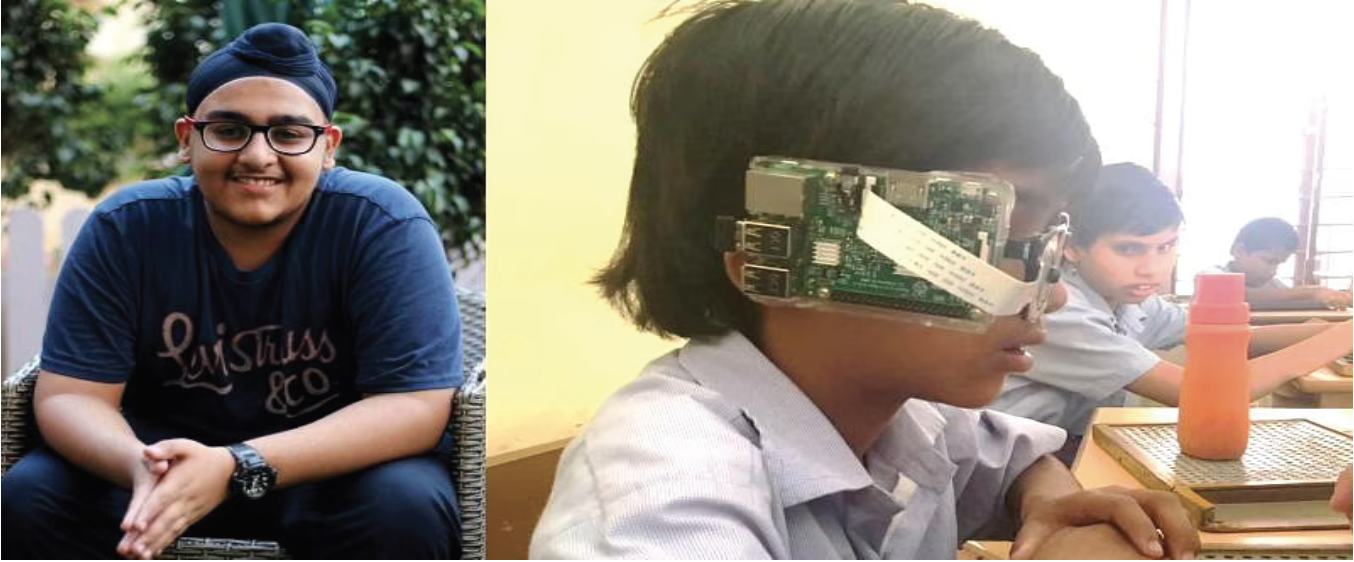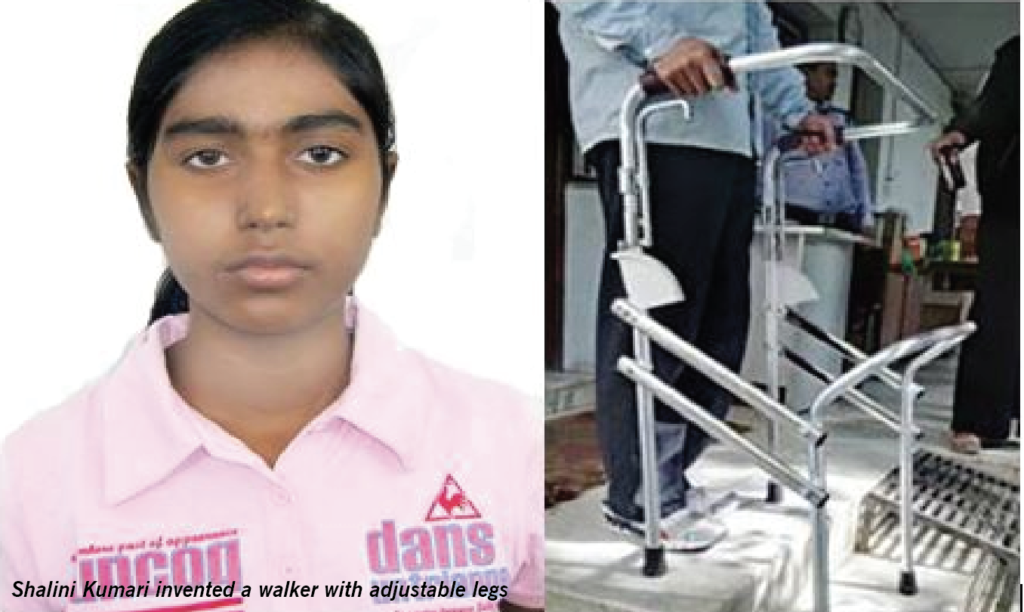India is witnessing a welcome rise in the number of socially conscious young inventors who are fabricating technologies that have the potential to make life easier and bearable for people at large, across spheres, says Mamta Gupta.
India’s innovation and design landscape has been expanding fast over the last few years. More interestingly, the segment is witnessing many young inventors and designers who are building path-breaking technologies and devices. Many such innovators are also creating solutions that affect the masses and are beneficial for public at large.
More recently, such socially driven young inventors are coming to the fore. They say necessity is the mother of invention. These teen social inventors are empathetic and sensitive to the needs of people and are using their skills and brilliance to make the world a better place to live in.
Innovation for the infirm
If it were not for the difficulties faced by her grandfather, Shalini Kumari probably would not have thought of inventing a walker with adjustable legs. She was so moved by her grandfather’s plight that she designed a great walker to help the physically weak climb stairs, a formidable task for the infirm, and landed in the NIF-India’s league of winners.
A resident of Patna, Bihar, Shalini thought of making the innovative walker when her grandfather met with an accident that left him physically weak and dependent. He could use a regular walker to walk but not to climb stairs that he used to climb in a jiffy, earlier, to get to the roof of the house for his daily walks in the terrace garden. With the regular walker he could walk on an even surface but it was not flexible enough to be used on stairs. Noticing her grandfather’s helplessness to do what is supposedly a ‘simple task’, Shalini decided to ‘fix’ the situation.
She designed a walker that had adjustable front legs that could be used to climb stairs. The then 12-year-old design was a walker with a spring and self-locking front legs. The person using the walker has to push the front legs of the walker on the upper stair and the rear legs rest on the lower stair. This stabilises the walker and makes it strong enough to hold the weight of the person on it. The flexible and stabilising mechanism enables the user to climb the stairs using the adjustable legs of the walker.
The walker can hold a weight of up to 100 kg and can be adjusted for different surfaces. The adjustable walker also has a foldable seat, horn and a light attached to it. Shalini thought of the design in a jiffy but putting her idea into practice was a challenge given the limitation of resources and experience to create such a thing. It was then the National Innovation Foundation’s IGNITE awards for young innovators came along and gave Shalini the impetus and support she needed at the time.
The issue that Shalini tackled is faced by millions across India, in particular, and the world at large. After China, India is the second highest population in the world. The number of elderly in India, concurrently, is high too. Among health issues that plague the elderly is the one about balance which affects daily life. An innovation as unique as the adjustable walker provides the much-needed adjustment that supplements an elderly person’s quality of life immensely.
Device to assist the visually impaired
Gurugram-based teenager Gursimran Singh built a device that helps the visually impaired to read. The assistive device called EyeScribe helps the visually impaired experience the joy of reading. He thought of creating the device when he witnessed the struggles of a relative who was visually impaired. Gursimran would see the relative struggle every day. He would ask himself what he could do to help the visually impaired. The struggles were particularly pronounced when the relative had to read voluminous books printed in Braille.

Gursimran designed the device in three months and it was first screened at the Atal Tinkering Lab Innovation Challenge by NITI Ayog in the FICCI Auditorium in November 2016. EyeScribe is a ‘wearable technology that captures images using a camera and produces an audio output using a text to speech engine’. The device has received several recognitions, awards and funding owing to the uniqueness of the invention.
Using coding skills to solve real problems
Naman Tiwari is a developer of 22 apps that cover a wide range of subjects such as women safety and security, malaria detection, education, etc. Even as an 11-year-old, Shahjahanpur-based Naman picked up coding as a hobby and learnt mobile app development on his own. Many of his apps are available on Google Play Store. Despite no access to fancy devices or formal training in app development of programming language, Naman achieved the extraordinary feat with sheer determination and focus.
In the initial phase, Naman was developing entertainment apps. When he saw the problems in the medical industry in the country, he quickly shifted to social awareness apps. Two of his apps called Malaria Defender and Secure Girls are particularly garnering positive response. His most complex and popular application Malaria Defender helps detect malaria in seconds. Malaria is a dreadful disease and wreaks havoc in the endemic zones. The app takes a few seconds to check the symptoms of malaria in a person and gives a prescribed health report. It’s a technological solution for those who cannot afford the doctor’s fees. The app can even work offline. The app got selected in the Facebook Start Bootstrap Programme.
On the other hand, Secure Girls is an app for women’s safety. Secure Girls provides important helpline information to women. It also has a panic button which can be used to send an emergency message. In the future, Naman dreams of running his software development company and creating change in people’s lives.
Tool to identify ‘strays’
Bengaluru-based Aparna Gupte from National Public School developed a software tool to recognise and track stray dogs for vaccination. She realised that the vaccination attempts by civic authorities could be made more efficient if they had a proper recording system. So, she decided to make one for them. She first obtained pre-trained neural networks capable of identifying dogs in images extracted from video recordings and then used a modified face recognition algorithm to detect unique markings and features of stray dogs. Aparna’s model was able to obtain 92 per cent accuracy.
Another student from National Public School, Bengaluru, Rishank Kanaparti realised how using high beam headlights on the roads at night could lead to accidents that could easily have been avoided. So, he used Artificial Intelligence to develop an AI-powered solution to manage the issue at hand. The sensors detect an oncoming vehicle and the system automatically dipsthe car headlights down until the other car passes, thereby keeping both the vehicles safe. It’s an affordable solution and can be integrated with most vehicles.
Innovation to tackle malnutrition
Bengaluru-based Ayush Gharat knew he had to do something when he visited an Anganwadi for a school project. He realised how real the problem of malnutrition in the country was. He decided to help the Anganwadi centres by using technology and designed a software called mNutrition. The tool allows employees to diagnose malnutrition in children below the age of five by comparing their height, weight and age against the World Health Organisation (WHO) standards. This helps in early detection and timely treatment of the affected children.

